Lecture 13 Restructuring (2) 词序调整
英语专业八级翻译指导词序调整
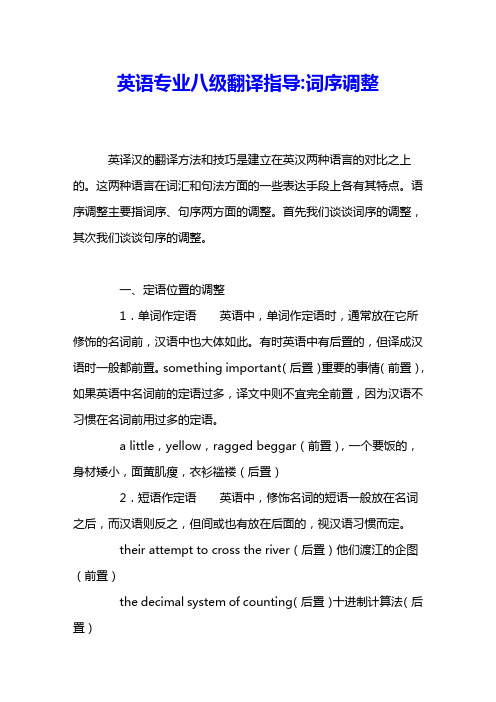
英语专业八级翻译指导:词序调整英译汉的翻译方法和技巧是建立在英汉两种语言的对比之上的。
这两种语言在词汇和句法方面的一些表达手段上各有其特点。
语序调整主要指词序、句序两方面的调整。
首先我们谈谈词序的调整,其次我们谈谈句序的调整。
一、定语位置的调整1.单词作定语英语中,单词作定语时,通常放在它所修饰的名词前,汉语中也大体如此。
有时英语中有后置的,但译成汉语时一般都前置。
something important(后置)重要的事情(前置),如果英语中名词前的定语过多,译文中则不宜完全前置,因为汉语不习惯在名词前用过多的定语。
a little,yellow,ragged beggar(前置),一个要饭的,身材矮小,面黄肌瘦,衣衫褴褛(后置)2.短语作定语英语中,修饰名词的短语一般放在名词之后,而汉语则反之,但间或也有放在后面的,视汉语习惯而定。
their attempt to cross the river(后置)他们渡江的企图(前置)the decimal system of counting(后置)十进制计算法(后置)二、状语位置的调整1.单词作状语英语中单词作状语修饰形容词或其他状语时,通常放在它所修饰的形容词或状语的前面,这一点与汉语相同。
He was very active in class.(前置)他在班上很活跃。
(前置)语中单词作状语修饰动词时,一般放在动词之后,而在汉语里则放在动词之前。
Modern science and technology are developing rapidly.(后置)现代科学技术正在迅速发展。
(前置)英语中表示程度的状语在修饰状语时可前置也可后置,而在汉语中一般都前置。
He is running fast enough(后置)他跑得够快的了。
(前置)2.短语作状语英语中短语状语可放在被修饰的动词之前或之后,译成汉语时则大多数放在被修饰的动词之前,但也有放在后面的。
翻译中的遣词用句

基本的翻译技巧一般包括1).Diction(选词用字); 2).Amplification(增益); 3).Omission(省略);4).Repetiton(重复);5).Conversion(转换); 6).Restructuring(词序调整); 7).Negation(正说反译,反说正译);8).Division(长句拆译).遣词用字是任何翻译工作者自始至终需面临的一个现实问题。
由于英汉分属不同的语系,所以在翻译时源语与译语之间往往没用相对固定的词义对应关系。
本期用对比的方式归纳了英汉词字层次上的五种对应情况:1.完全对等,2.多词同义,3.一词多义,4.词义交织,5.无对等词语。
词义辨析是遣词用字的前提。
本期从四个角度探讨了如何判断某一英语词语的准确含义,即1.根据构词法辨别词义;2.根据指代关系辨别词义;3.根据上下文或词的搭配辨别词义;4.根据不同学科或专业类型辨别词义。
在词义辨析的基础上,本期归纳了英语词语翻译的8种常用技巧:1.推演法,2.移植法,3.引伸法,4.替代法,5.释义法,6.合并法,7. 图形法和8.音译法。
1. Correspondence Between English and Chinese at Word Level----英汉词字层次上的五种对应情况In most cases there is no existing pattern for sentence translation, nor are there fixed rules for word transformation. Generally speaking, the correspondence between English and Chinese at word level may be categorized as follows:1) Word-for-word CorrespondenceThis is most evidently shown in proper nouns and technical terms.For example: Marxism = 马克思主义Aspirin =阿斯匹林2) One Word with Multiple Equivalents of the Same MeaningThis is a common case in translation.For example:犬:dog, hound, spaniel, mastiff, pointer, setter, retriever, terrier……3) One Word with Several Equivalents of Different MeaningThis is also very common in translation. For example:carry: 搬、运、送、提、拎、挑、担、抬、背、扛、搂、抱、端、举、夹、捧…..走:walk, saunter, amble, stride, trudge, trapes, shamble, prance, scamper, clump, tiptoe ….羊:sheep, goat, ram, ewe, lamb……4) Equivalents Interwoven with One Another5) Words Without EquivalentsIn this case, an explanation is given instead of an equivalent.For example:clock-watcher: 老是看钟等下班的人阴:(in Chinese thought) the soft inactive female principle or force in the world阳:(in Chinese thought) the strong active male principle or force in the world(目不识)丁: (not know one's) ABC2. Methods to Discriminate the Original Meaning of an English Word-----词义辨析Since English words are prone to various meanings, it is of vital importance for a translator to discern the right meaning of a given word. And the following are the major methods of discriminating word meaning suggested by some linguists.1) Judging from the Word FormationIn order to discriminate the original meaning of an English word, it is necessary for us to have a knowledge of English lexicology, and specifically, a knowledge of word formation, such as compounding, derivation, affixation, blending, acronym, clipping, etc. A good command of them will help to shed light on the correct meaning of some difficult words.For example, the word ""parabiospheric"", which consists of para-(outside) +bio-(biologic) +spheric (having the form of a sphere). After a brief analysis, we may safely put it into ""外生物层的"". Another more complicated instance, pneumonoultramicroscopicsilicovolcanoconiosis. This extremely long word seems appallingly complicated. However, an anatomic study of its composition enables us to get a clear understanding of its meaning: pneumono- (of lung) +ultra- (beyond) + micro (very small) + scopic- (of viewing or observing) + silico- (of silicon)+ volcano + coni- ( koni, of dust) + osis (forming the name of a disease). Even if we are not sure of the equivalent of this medical term, we may roughly get the right meaning of the long word: a kind of lung disease caused by extremely small silicon particles. And a look into some dictionary leads us to the definite answer: 硅酸盐沉着病,肺尘病(一种矿工易染的病)。
语序调整翻译法

英汉两者语言在词序上的差异
• 3)定语的词序差异: • 英语中,定语的位置灵活多变,可置于被修饰名 词之前或之后,还可同时置于被修饰词的之前和 之后。 • 汉语中,定语则通常只能位于被修饰的名词之前。 Traditional Chinese virtue • 例如排序差异: 中华传统美德 • 英:限定词 - 描绘词 - 大小新旧 - 颜色 - 类别 + 中 心名词 • 汉:邻属关系 - 时间处所 - 指示代词或量词 - 动词 性词语和主谓短语 - 形容词性词语 + 性质类别或 范围的名词、动词
• • • • • 一是扼要你出全句的轮廓; 二是要根据上下文和全句的内容领会要旨; 三是要辨清全句的主从结构; 四是要找出各句之间从属关系。 找出句子主句 找出主句中的主谓语,了解 中心思想 理清主句与从句,主要成分与次 要成分, 修饰与被修饰等各层次关系和内容 按照逻辑顺序把句子的各个部分内容串成 一个完整的话语。
例析1
• International countertrade (对等/对销/反向贸 易) is a practice whereby a supplier commits contractually – as a condition of sale – to reciprocate(回报) and undertake certain specified commercial initiatives(商务提案) that compensate and benefit the buyer. • 国际对销贸易,作为一种销售条件,是指供 应方以合同的方式 承诺对某些特别的、给购 买方以补偿和利益的商务提案予以回报和承 办的一种做法。
长句的翻译
长句翻译的要点
• 长句是指语法结构比较复杂、从句和修饰 语较多,包含的内容层次在一个以上的句 子 • 对于长句的翻译,有两点至关重要:一是 对原文的准确理解;二是在译文当中恰如 其分的表达。
Lecture_7_句序调整翻译

The librarians have compiled a card-index catalogue so that they can afford facilities for reference. 为便于参考起见,图书馆馆员们编制了索引目 录卡。 No matter how hard he tried, he failed at last. 不管他怎样努力,最后还是没有成功。
参考译文:
这次周年纪念会应该是一个老老实实地评估 我们过去的失误的时机,同时也应该是一个表 达我们有同样决心要做好今后工作的时机。这 样,我们就可免遭挫折,并可把这次周年纪念 变成一种鼓舞和成就。当我讲这番话时,我相 信---今天上午我们听到的发言也使我相信--我是代表联合国每一位真诚和严肃的代表讲话 的。
一、英汉词序差异
English sentence patterns: Minor—Major Near—Far Specific---General Weak---Strong 汉语一般把重要的、语气强的词语紧靠中心词,而英语恰 恰相反。 His address is 3612 Market Street,Philadelphia, PA. 19109,USA. 他的地址是美国宾夕法尼亚州费城市场街3612号,邮政 编码19104。 My uncle passed away in hospital at 2: 30 a. m. on September 12,1999. 我的伯父于1999年,月12日凌晨2点30分在医院逝世。 一定要分清敌我。 We must draw a clear distinction between ourselves and the enemy.
高中英语人教版必修二词汇词性转换
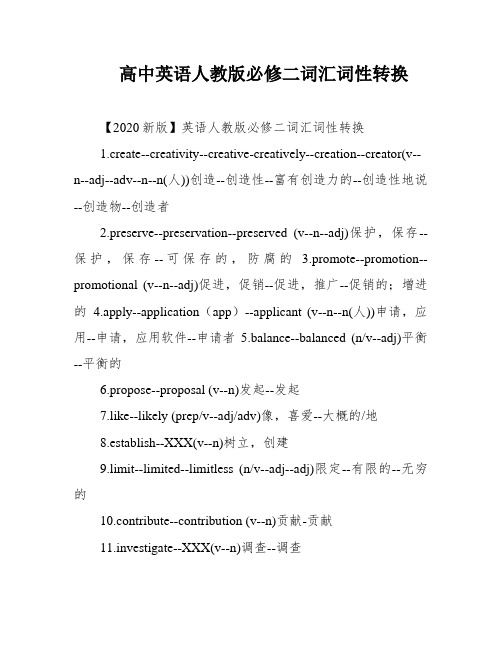
高中英语人教版必修二词汇词性转换【2020新版】英语人教版必修二词汇词性转换1.create--creativity--creative-creatively--creation--creator(v--n--adj--adv--n--n(人))创造--创造性--富有创造力的--创造性地说--创造物--创造者2.preserve--preservation--preserved (v--n--adj)保护,保存--保护,保存--可保存的,防腐的3.promote--promotion--promotional (v--n--adj)促进,促销--促进,推广--促销的;增进的4.apply--application(app)--applicant (v--n--n(人))申请,应用--申请,应用软件--申请者5.balance--balanced (n/v--adj)平衡--平衡的6.propose--proposal (v--n)发起--发起7.like--likely (prep/v--adj/adv)像,喜爱--大概的/地8.establish--XXX(v--n)树立,创建9.limit--limited--limitless (n/v--adj--adj)限定--有限的--无穷的10.contribute--contribution (v--n)贡献-贡献11.investigate--XXX(v--n)调查--调查12.conduct--conduction--conductor(v/n--n--n(人))组织,安排,传导--传导--指挥,售票员13.appear--appearance--disappear--disappearance(v--n--反v--n)出现-出现-消失-消失14.profession--professional--professor(n--adj/n--n(人))职业--专业的,专业人员--专家15.enter--entrance(v--n)进入--入口16.forgive--forgiveness(v--n)原谅--原谅17.digit--digital(n--adj)数字--数字的18.quality--qualify--qualified(n--v--adj)质量--达到标准,使有资格--有资格的19.tradition--traditional(n--adj)传统--传统的20.far--further--furthest(adj--比较级--最高级)远的--更进一步--最大程度21.history--historic (n--adj)历史--历史(性)的;有历史记载的pare--comparison--comparative (v--n--adj)比较--比较,对照--相对的23.identity--identify(n--v)身份--确认24.post--poster--postman (v--n--n(人))发布--海报--邮递员25.legal--legally--illegal--illegally(adj--adv--反adj--adv)正当的-正当地-不法的--不法地26.hunt--hunter (v--n(人))狩猎--猎人27.immediate--immediately(adj--adv)即刻的--立刻28.alarm--alarming--alarmed(v/n--adj--adj)惊骇/警报--使人震动的--忧郁害怕的29.rate--rating (n/v--n)速率/划分品级--品级,级别30.extinct--extinction(adj--n)已灭绝的--灭绝31.aware--awareness (adj--n)有……意识的--意识32.danger--endanger--dangerous--endangered (n--v--adj--adj)风险--使遭风险;危及--风险的--靠近灭尽的33.concern--concerned--concerning (v--adj--prep)关怀,涉及--关注的,忧虑的--有关的34.live--lively--living--alive(v--adj--adj--adj)居住--活泼的--居住的--在世的35.press--pressure (v--n)按压--压力36.reserve--reservation(v/n--n)保留,保护区--预定37.observe--observation(v--n)窥察,遵照---窥察38.beauty--beautify--beautiful-beautifully (n--v--adj--adv)美-美化-美丽的-美丽地39.effect--effective--effectively-efficiency(n--adj--adv--n)效果--有效的--有效地--有效性40.recover--recovery(v--n)康复--恢复41.remove--removal--remover(v--n--n(人))解雇,移开--革职,搬家--搬运工42.intend--intention(打算,打算--企图,打算)43.XXX(v--n)要挟44.exist--existence (v--n)存在,保存45.harmony--harmonious(n--adj)和谐--和谐的46.reduce-- reduction(v--n)削减47.neighbor--neighborhood(adj--n)临近的--附近48.emotion--emotional(n--adj)豪情--豪情的ual--usually--unusual(adj--adv--反adj)平日的--平日地--不寻常的50.blog--blogger(n/v--n(人))博客,写博客--博主51.chat--chatting(n/v--现在分词)闲聊52.convenient--convenience--inconvenient--inconvenience(adj--n反adj--n)方便的-方便-不方便的-不方便53.stick--stuck(v--adj)粘住--卡住的54.benefit--beneficial (n/v--adj)优点,获益---有优点的55.distance--distant(n--adj)远方--间隔远的56.inspire--inspiring--inspired--inspiration(v--adj--adj--n)激励,启发-鼓舞人心的-受到鼓舞的-激励,灵感57.access--accessible(n/v--adj)通道/进入--可进入的58.tough--toughly (adj--adv)坚强的,坚固的,艰难的--坚强地,能吃苦耐劳地,固执地59.function--functional(n/v--adj)功能,起作用--功能的60.account--accountable--accountant(n/v--adj--n(人))账目,解释--有责任的--会计61.theft--thief(n--n(人))偷窃--小偷62.rude--rudely--rudeness(adj--adv--n)卤莽的--卤莽地--卤莽63.particular--particularly(adj--adv)特定的--出格地64.embarrass--embarrassing--embarrassed--embarrassment(v--adj--adj--n)使尴尬--令人尴尬的--感到尴尬的--尴尬65.upset--upsetting (v/adj--adj)打翻,难过的--使人心烦意乱的66.define--definition(v--n)阐明;限定;给…下定义---定义,释义67.puzzle--puzzling--puzzled(v--adj--adj)使利诱--使人利诱的--感到利诱的68.defend--defence(v--n)防御,保卫69.surround--surrounding--surroundings(v--adj--n)围困--四周的--情况70.evident--evidence (adj--n)明显的--证据,证明71.achieve--achievement (v--n)完成--成就72.locate--located--location (v--adj--n)确定…的位置--位于的--位置73.announce--announcement--announcer(v--n--n(人))播送,公布--布告,启事--播送员74.approach--approaching (v/n--adj)靠近,办法--靠近的75.sure--ensure(adj--v)肯定的--确保76.generous--generously--generosity (adj--adv--n)慷慨的--慷慨地--慷慨77.eager--eagerly--eagerness(adj--adv--n)热切的,盼望的--渴望地,热切地--渴望,热心,热切。
基本的翻译技巧一般包括
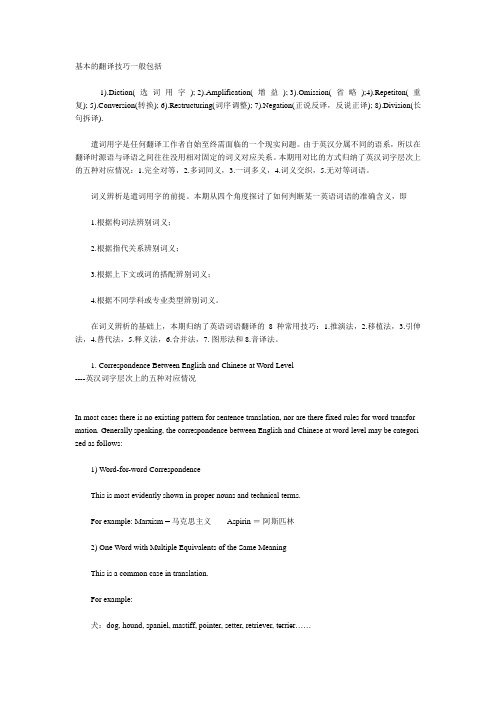
基本的翻译技巧一般包括1).Diction(选词用字); 2).Amplification(增益); 3).Omission(省略);4).Repetiton(重复); 5).Conversion(转换); 6).Restructuring(词序调整); 7).Negation(正说反译,反说正译); 8).Division(长句拆译).遣词用字是任何翻译工作者自始至终需面临的一个现实问题。
由于英汉分属不同的语系,所以在翻译时源语与译语之间往往没用相对固定的词义对应关系。
本期用对比的方式归纳了英汉词字层次上的五种对应情况:1.完全对等,2.多词同义,3.一词多义,4.词义交织,5.无对等词语。
词义辨析是遣词用字的前提。
本期从四个角度探讨了如何判断某一英语词语的准确含义,即1.根据构词法辨别词义;2.根据指代关系辨别词义;3.根据上下文或词的搭配辨别词义;4.根据不同学科或专业类型辨别词义。
在词义辨析的基础上,本期归纳了英语词语翻译的8种常用技巧:1.推演法,2.移植法,3.引伸法,4.替代法,5.释义法,6.合并法,7. 图形法和8.音译法。
1. Correspondence Between English and Chinese at Word Level----英汉词字层次上的五种对应情况In most cases there is no existing pattern for sentence translation, nor are there fixed rules for word transfor mation. Generally speaking, the correspondence between English and Chinese at word level may be categori zed as follows:1) Word-for-word CorrespondenceThis is most evidently shown in proper nouns and technical terms.For example: Marxism = 马克思主义Aspirin =阿斯匹林2) One Word with Multiple Equivalents of the Same MeaningThis is a common case in translation.For example:犬:dog, hound, spaniel, mastiff, pointer, setter, retriever, terrier……3) One Word with Several Equivalents of Different MeaningThis is also very common in translation. For example:carry: 搬、运、送、提、拎、挑、担、抬、背、扛、搂、抱、端、举、夹、捧…..走:walk, saunter, amble, stride, trudge, trapes, shamble, prance, scamper, clump, tiptoe ….羊: sheep, goat, ram, ewe, lamb……4) Equivalents Interwoven with One Another5) Words Without EquivalentsIn this case, an explanation is given instead of an equivalent.For example:clock-watcher: 老是看钟等下班的人阴: (in Chinese thought) the soft inactive female principle or force in the world阳: (in Chinese thought) the strong active male principle or force in the world(目不识)丁: (not know one's) ABC2. Methods to Discriminate the Original Meaning of an English Word-----词义辨析Since English words are prone to various meanings, it is of vital importance for a translator to discern the rig ht meaning of a given word. And the following are the major methods of discriminating word meaning sugge sted by some linguists.1) Judging from the Word FormationIn order to discriminate the original meaning of an English word, it is necessary for us to have a knowledge of English lexicology, and specifically, a knowledge of word formation, such as compounding, derivation, af fixation, blending, acronym, clipping, etc. A good command of them will help to shed light on the correct me aning of some difficult words.For example, the word ""parabiospheric"", which consists of para-(outside) +bio-(biologic) +spheric (havingthe form of a sphere). After a brief analysis, we may safely put it into ""外生物层的"". Another more complicated instance, pneumonoultramicroscopicsilicovolcanoconiosis. This extremely lon g word seems appallingly complicated. However, an anatomic study of its composition enables us to get a cl ear understanding of its meaning: pneumono- (of lung) +ultra- (beyond) + micro (very small) + scopic- (of vi ewing or observing) + silico- (of silicon)+ volcano + coni- ( koni, of dust) + osis (forming the name of a dise ase). Even if we are not sure of the equivalent of this medical term, we may roughly get the right meaning of the long word: a kind of lung disease caused by extremely small silicon particles. And a look into some dicti onary leads us to the definite answer: 硅酸盐沉着病,肺尘病(一种矿工易染的病)。
词类转换词序调整

Conversion between parts Байду номын сангаасf speech
noun—verb • They went on strike in demand of a 40 percent wage increase. 译文:他们举行罢工,要求工资增加40%。 • The teacher gave a further explanation of the meaning of the sentence. 译文:老师进一步解释了那个句子的意思。
Conversion between parts of speech
adverb—verb • After a careful investigation they found the design behind. 译文:经过仔细地研究后,他们发现这个设 计落后了。 • Each time out was a happy experience. 译文:每次出游都很愉快。 • 今晚放映什么电影? 译文:What film will be on this evening?
Conversion between parts of speech
prep—verb • Government of the people, by the people and for the people shall not perish from the earth. 译文:一个民有、民治、民享的政府永 远不会消失。
Different Thinking Patterns
English(外展螺旋式) 由点及面 由小到大 由近及远 Chinese(内旋式) 由面到点 由大到小 由远及近
由轻到重 由弱到强
由重到轻 由强到弱
Different Thinking Patterns
lecture翻译技巧八顺序和逆序法

1. The dockers were seen unloading the chemical fertilizer from S.S. “Apollo”.
2. The Finnish Trade Mission was given a warm welcome by their counterparts.
我们天天在教室里认真学习。
2. His address is 518 Wenhua Road, Guzan Town, PA626001, Kangding. 他的地址是康定县姑咱镇文化路518号,邮编编码 626001。
3. They were badly defeated at Luding in November, 1945. 他们于1945年11月在泸定附近大败。
+post-) both his two sisters (pre- + central + post-)
我的三位朋友 她的许多本书
Fourth, general principal for placing several attributive modifiers before noun in Chinese:
predeterminer + central determiner + postdeterminer
all the four teachers (pre- + central + post-) all your three books (pre- + central + post-) all these last few days (pre-+central+post-
词序调整
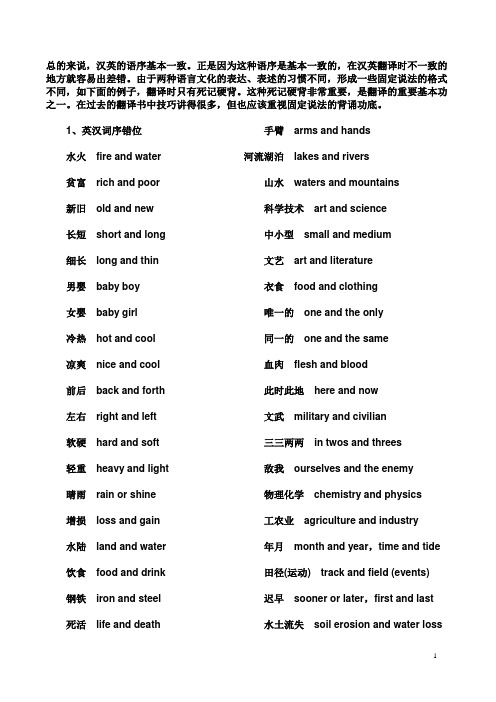
总的来说,汉英的语序基本一致。
正是因为这种语序是基本一致的,在汉英翻译时不一致的地方就容易出差错。
由于两种语言文化的表达、表述的习惯不同,形成一些固定说法的格式不同,如下面的例子,翻译时只有死记硬背。
这种死记硬背非常重要,是翻译的重要基本功之一。
在过去的翻译书中技巧讲得很多,但也应该重视固定说法的背诵功底。
1、英汉词序错位水火fire and water 贫富rich and poor 新旧old and new长短short and long 细长long and thin 男婴baby boy女婴baby girl冷热hot and cool凉爽nice and cool 前后back and forth 左右right and left软硬hard and soft 轻重heavy and light 晴雨rain or shine增损loss and gain 水陆land and water 饮食food and drink 钢铁iron and steel 死活life and death手臂arms and hands河流湖泊lakes and rivers山水waters and mountains科学技术art and science中小型small and medium文艺art and literature衣食food and clothing唯一的one and the only同一的one and the same血肉flesh and blood此时此地here and now文武military and civilian三三两两in twos and threes敌我ourselves and the enemy物理化学chemistry and physics工农业agriculture and industry年月month and year,time and tide田径(运动)track and field (events)迟早sooner or later,first and last水土流失soil erosion and water loss新郎新娘the bride and the bridegroom手疾眼快quick of eye and deft of hand喜怒哀乐anger, grief, joy and happiness水乳交融as well blended as milk and water2、有一些情况汉英说法顺序差不多如:上下up and down高低high and low老幼old and young父母father and mother夫妇man and wife黑白black and white(生活)沉浮ups and downs彻头彻尾from head to foot来龙去脉from beginning to end来来往往come and go, back and forth 3、汉语习语中常有同义重复表达。
英汉互译Unit 6 Restructuring

• His failure to observe the safety regulations resulted in a serious injury. • 他没遵守安全规则,受了重伤。 他没遵守安全规则,受了重伤。 • I wrote four books in three years, a record never touched before. • 我三年写了四本书,打破了以往 我三年写了四本书, 的纪录。 的纪录。
11
句序调整
• 时间顺序、逻辑顺序 时间顺序、
• 顺序法 • 逆序法 • 时序法 • 拆分法 • 合并法
12
顺序法(按原句语序翻译) 顺序法(按原句语序翻译)
• It was strange that a day of war was a day we stood still. We couldn’t move — that must have been the whole idea — so we had no choice but to watch. • 奇怪的是战争的当天我们却按兵不动。我们不 奇怪的是战争的当天我们却按兵不动。 能动弹——这就是这次战争的整个含意 这就是这次战争的整个含意——除 能动弹——这就是这次战争的整个含意——除 了监视敌人,我们别无他法。 了监视敌人,我们别无他法。 • 为了生存,为了自己和子孙后代的衣食住行, 为了生存,为了自己和子孙后代的衣食住行 衣食住行, 人类和大自然不断进行斗争。 人类和大自然不断进行斗争。 • In order to survive, to feed, clothe and shelter himself and his children, man is engaged in a constant struggle with nature.
第八讲 结构调整Restructuring
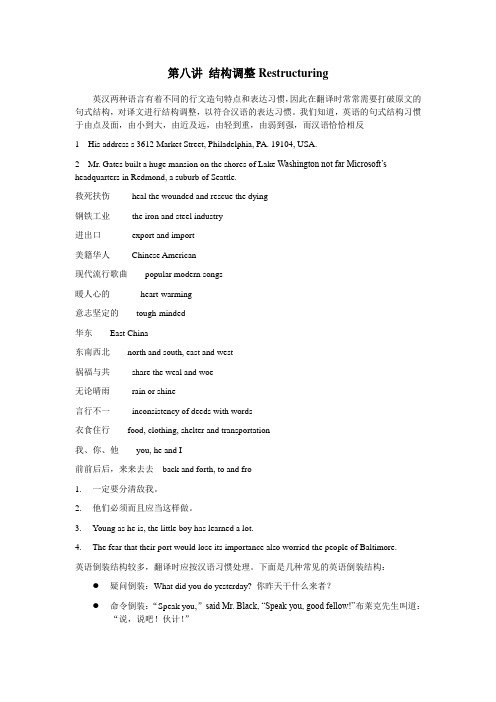
第八讲结构调整Restructuring英汉两种语言有着不同的行文造句特点和表达习惯,因此在翻译时常常需要打破原文的句式结构,对译文进行结构调整,以符合汉语的表达习惯。
我们知道,英语的句式结构习惯于由点及面,由小到大,由近及远,由轻到重,由弱到强,而汉语恰恰相反1 His address s 3612 Market Street, Philadelphia, PA. 19104, USA.2 Mr. Gates built a huge mansion on the shores of Lake Washington not far Microsoft’s headquarters in Redmond, a suburb of Seattle.救死扶伤heal the wounded and rescue the dying钢铁工业the iron and steel industry进出口export and import美籍华人Chinese American现代流行歌曲popular modern songs暖人心的heart-warming意志坚定的tough-minded华东East China东南西北north and south, east and west祸福与共share the weal and woe无论晴雨rain or shine言行不一inconsistency of deeds with words衣食住行food, clothing, shelter and transportation我、你、他you, he and I前前后后,来来去去back and forth, to and fro1.一定要分清敌我。
2.他们必须而且应当这样做。
3.Young as he is, the little boy has learned a lot.4.The fear that their port would lose its importance also worried the people of Baltimore.英语倒装结构较多,翻译时应按汉语习惯处理。
翻译过程:理解与表达
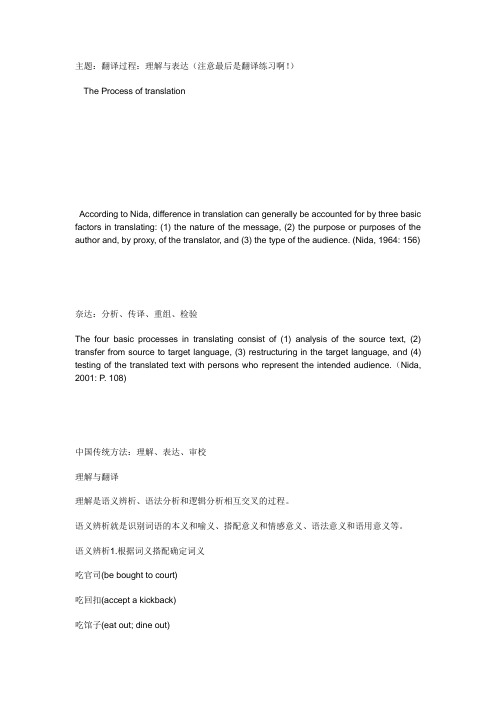
主题:翻译过程:理解与表达(注意最后是翻译练习啊!)The Process of translationAccording to Nida, difference in translation can generally be accounted for by three basic factors in translating: (1) the nature of the message, (2) the purpose or purposes of the author and, by proxy, of the translator, and (3) the type of the audience. (Nida, 1964: 156)奈达:分析、传译、重组、检验The four basic processes in translating consist of (1) analysis of the source text, (2) transfer from source to target language, (3) restructuring in the target language, and (4) testing of the translated text with persons who represent the intended audience.(Nida, 2001: P. 108)中国传统方法:理解、表达、审校理解与翻译理解是语义辨析、语法分析和逻辑分析相互交叉的过程。
语义辨析就是识别词语的本义和喻义、搭配意义和情感意义、语法意义和语用意义等。
语义辨析1.根据词义搭配确定词义吃官司(be bought to court)吃回扣(accept a kickback)吃馆子(eat out; dine out)吃亏(suffer losses)吃枪子(be hit by a bullet)吃得开(be popular)吃闲饭(unemployed and without income)吃香(popular)(1) 老战士(2) 老领导(3) 老师傅(4) 老闺女(5) 老黄牛(6) 老芹菜(7) 老皇历(8) 老生常谈(1) 老战士a veteran (2) 老领导a senior leader(3) 老师傅a master craftsman(4) 老闺女the youngest daughter(5) 老黄牛a willing ox(6) 老芹菜overgrown celery(7) 老皇历last year's calendar(8) 老生常谈commonplace申请书报告书协议书成绩通知书(使用)说明书旅行委托书成交确认书电视机使用说明书白皮书家书无巧不成书letter of application;report; agreement;grade report;direction;booking form;sales confirmation;television operation guide;white book;a letter from home;no coincidence, no stories2.根据词类确定词义留得青山在,不怕没柴烧。
翻译的技巧——词序调整法
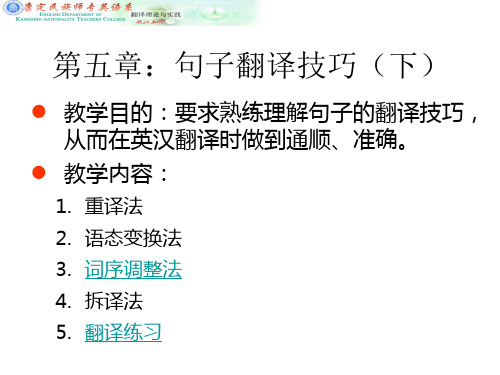
5
第五章:翻译技巧——词序调整法
Chinese: General principal for placing several attributive modifiers before noun
限制性(restrictive)
判断性
物主、国别 时间、地点 数量、指代
描述性 (descriptive)
12
第五章:翻译技巧——词序调整法
4. 拆分法( Division ): 将句中的插入成分提取出来 单独翻译,另起一句放在句末 1). They, not unexpectedly, did not respond. 没有答复,这完全是意料之中的事。 2). Illogically, she had expected some kind of miracle solution. 她满以为会有某种奇迹般的解决办法,这显然不 合情理。
6. Small and medium-sized countries, peasants who had
little or no land
[Original]
15
He bought a _______stamp.
a.Small Danish triangular green b.Danish small triangular green c.Triangular green small Danish d.Small triangular green Danish
我坚信,英国依然(应该)是欧共体中的一个积极的、 充满活力的成员,这是符合我国人民利益的。(部分 倒置)
2).改革开放以来,中国发生了巨大的变化。
Great changes have taken place in China since the introduction of the reform and opening policy.(全部倒置)
词序调整法
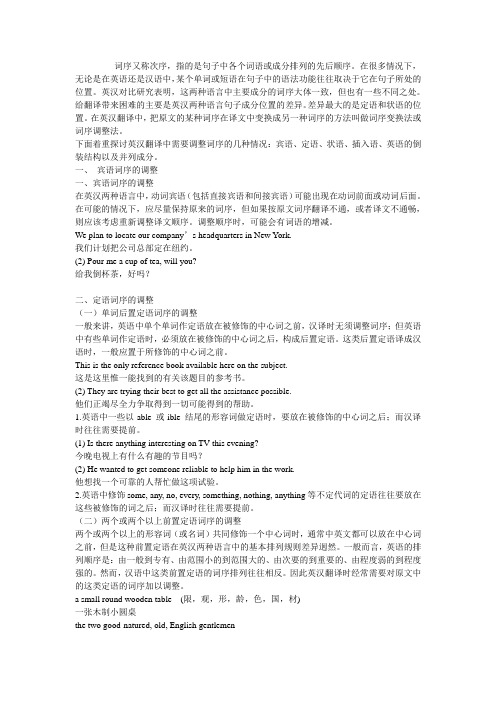
词序又称次序,指的是句子中各个词语或成分排列的先后顺序。
在很多情况下,无论是在英语还是汉语中,某个单词或短语在句子中的语法功能往往取决于它在句子所处的位置。
英汉对比研究表明,这两种语言中主要成分的词序大体一致,但也有一些不同之处。
给翻译带来困难的主要是英汉两种语言句子成分位置的差异。
差异最大的是定语和状语的位置。
在英汉翻译中,把原文的某种词序在译文中变换成另一种词序的方法叫做词序变换法或词序调整法。
下面着重探讨英汉翻译中需要调整词序的几种情况:宾语、定语、状语、插入语、英语的倒装结构以及并列成分。
一、宾语词序的调整一、宾语词序的调整在英汉两种语言中,动词宾语(包括直接宾语和间接宾语)可能出现在动词前面或动词后面。
在可能的情况下,应尽量保持原来的词序,但如果按原文词序翻译不通,或者译文不通畅,则应该考虑重新调整译文顺序。
调整顺序时,可能会有词语的增减。
We plan to locate our company’s headquarters in New Y ork.我们计划把公司总部定在纽约。
(2) Pour me a cup of tea, will you?给我倒杯茶,好吗?二、定语词序的调整(一)单词后置定语词序的调整一般来讲,英语中单个单词作定语放在被修饰的中心词之前,汉译时无须调整词序;但英语中有些单词作定语时,必须放在被修饰的中心词之后,构成后置定语。
这类后置定语译成汉语时,一般应置于所修饰的中心词之前。
This is the only reference book available here on the subject.这是这里惟一能找到的有关该题目的参考书。
(2) They are trying their best to get all the assistance possible.他们正竭尽全力争取得到一切可能得到的帮助。
1.英语中一些以-able或-ible结尾的形容词做定语时,要放在被修饰的中心词之后;而汉译时往往需要提前。
人教版必修二单元重点词汇词性转换汇总(2020新版)

人教版必修二单元重点词汇词性转换汇总(2020新版)Unit 1create v.创造——creation n.创造力——creative adj.创造性的,有创造力的,有创意的——creatively adv.创造性地,有创造力地former adj.以前的,(两者中)前者的——latter adj.后者的preserve v.保存,保护,维持n.保护区——preservation n.保护,保存promote v.促进,提升,推销,晋级——promotion n.促进,提升apply v.应用,申请——application n.申请(表),用途,运用,应用(程序)balance v.平衡;权衡n.天平;平衡——balanced adj.保持平衡的propose v.提议——proposal n.提议,建议like v.喜欢——dislike v.不喜欢——likely adj.可能的——unlikely adj.不可能的establish v.建立——establishment n.建立limit n.限度,限制v.限制,限定——limited adj.有限的prevent v.阻止,阻碍,阻挠——prevention n.阻止lose v.丢失——loss n.丧失,损失——lost adj.迷失的,丢失的contribute v.捐献,捐款——contribution n.捐款,贡献,捐献investigate v.调查,研究——investigation n.调查——investigator n.调查人员conduct n.行为,举止,管理方法v.组织,安排,带领——conductionn.指挥——conductor n.指挥员,列车员donate v.捐赠,赠送,献——donation n.捐赠,捐赠物——donator n.捐赠人appear v.出现,露面——appearance n.出现,外表,外貌——disappear v.消失,灭绝——disappearance n.消失download v.下载n.下载——upload v. n.上传profession n.专业,职业——professional adj.专业的,职业的n.专业人员,职业选手——professor n.教授process n.过程,进程,步骤v.处理,加工——processed adj.加工过的quality n.质量,品质,素质,特征adj.优质的,高质量的——quantity n.数量;量qualify v.取得资格,是合格——qualification n.资格,学历——qualified adj.有资格的,有条件的tradition n.传统,传统的信仰或风俗——traditional adj.传统的compare v.比较——comparison n.比较,相比courage n.勇气——encourage v.鼓励——encouragement n.鼓励identity n.身份——identify v.确认,认出,找到culture n.文化——cultural adj.文化的protect v.保护——protection n.保护choose v.选择——choice n.选择main adj.主要的——mainly adv.主要地report v.报道——reporter n.记者exact adj.确切的——exactly adv.确切地destroy v.毁坏——destruction n.毁坏,破坏explain v.解释——explanation n.解释mean adj.吝啬的n.意味着——means n.方式,方法——meaning n.意思——meaningful adj.有意义的——meaningless adj.无意义的general adj.大体的,一般的——generally adv.大体上introduce v.介绍,引入——introduction n.介绍,引入teenage adj.十几岁的,青少年的——teenager n.青少年confuse v.使困惑,使迷惑——confused adj.困惑的,迷惑的——confusing adj.令人困惑的,令人迷惑的refer v.涉及,提及——reference n.参考,引文solve v.解决——solution n.解决,方案develop v.发展,养成——development n.发展,养成necessary adj. 必要的——necessarily adv.必要地——necessity n.必要性balance n. v.平衡——balanced adj.平衡的propose v.提议,建议——proposal n.提议science n.科学——scientist n.科学家——scientific adj.科学的govern v.管理——government n.政府safe adj.安全的——safety n.安全——safely adv.安全地work v.工作——worker n.工人——works n.作品count v.数数——countless adj.无数的near prep.附近——nearly adv.几乎,差不多,将近complete adj.完全的,彻底的——completely adv.完全地,彻底地harm v.伤害——harmful adj.有害的know v.知道——knowledge n.知识appreciate v.感激,欣赏,鉴赏——appreciation n.感谢,欣赏communicate v.交流——communication n.交流proud adj.自豪的,骄傲的——pride n.自豪,骄傲include v.包含,包括——including prep.包含present adj.现在的,目前的v.呈现——presentation n.呈现Unit 2legal adj.法律的;合法的——illegal adj.不合法的,非法的——illegally adv.不合法地,非法地hunt v.打猎,搜寻,追捕——hunter n.猎人immediate adj.立即的,马上的——immediately adv.立刻alarm v.使恐吓,使害怕,使担心n.恐慌,警报,警报器——alarming adj.惊人的,使人惊恐的——alarmed adj.担心的,害怕的rate n.速度,(比)率v.划分等级——rating n.等级,级别extinct adj.已灭绝的——extinction n.灭绝danger n.危险——endanger v.使遭受危险,危害——dangerous adj.危险的——dangerously adv.危险地live v.居住adj.现场的——living adj.居住的,活的,在用的n.生活,生计——alive adj.活着的,在世的concern v. (使)担忧;涉及;关系到n.担心; 关注;(利害)关系—— concerned adj.担心的;忧虑的——concerning prep.涉及adapt v.适应,改编——adaptation n.适应,改编adopt v.采用,收养——adoption n.采用,收养press v.按,压——pressure n.压力observe v.观察(到),注视,遵守——observation n.观察beauty n.美,美人,美好的东西——beautiful adj.美丽的——beautifully adv.漂亮地mind n.思想v.介意——remind v.提醒,使想起cover v.覆盖——recover v.恢复,康复,找回,寻回move v.移动——remove v.去除,移开,脱去——movement n.移动intend v.打算,计划,想要——intension n.目的,意图threat n.威胁——threaten v.威胁,危及exist v.存在——existence n.存在,生存——existent adj.存在的reduce v.减少——reduction n.减少emotion n.感情,情感,情绪——emotional adj.情感的,情绪化的skin n.皮,皮肤——skinny adj.皮包骨头的,瘦骨嶙峋的usual adj.通常的,寻常的——usually adv.通常,寻常——unusual adj.特别的,不寻常的Tibet n.西藏——Tibetan adj.西藏的,藏语的,藏族(人)的n.西藏人,藏族人,藏语protect v.保护——protection n.保护pollute v.污染——pollution n.污染lead v.领导,引领,带路——leader n.领导produce v.生产——producer n.生产商announce v.宣布,宣告——announcement n.宣布,宣告——announcer n.播音员,节目主持人value n.价值v.珍视——valuable adj.有价值的real adj.真的——really adv.真地——reality n.事实sad adj.悲伤的——sadness n.悲伤simple adj.简单的——simply adv.简单地constant adj.联系不断的,持续的n.常数——constantly adv.连续不断地,持续地organize v.组织——organization n.组织——organizer n.组织者Unit 3blog n.博客v.写博客——blogger n.博客作者,博主identity n.身份——identify v.确认convenient adj.方便的,近便的——convenience n.方便,便利——inconvenient adj.不方便的tough adj.艰难的,严厉的——toughly adv.艰难的,严厉的press v.按,压——pressure n.压力benefit n.益处v.使受益,得益于——beneficial adj.有益的distance n.距离——distant adj.远方的,遥远的inspire v.鼓舞,激励,启发思考——inspiration n.鼓舞,鼓励private adj.私人的个人的——privacy n.隐私,私密rude adj.粗鲁的,无理的——rudeness n.粗鲁,无礼particular adj.特定的,特别的,讲究的——particularly adv.特别,尤其embarrass v.使尴尬——embarrassing adj.让人难堪的——embarrassed adj.尴尬的,难堪的——embarrassment n.尴尬,难堪define v.给……下定义,界定,解释——definition n.释义——definite adj.一定的,肯定的——definitely adv.肯定,确切地safe adj.安全的——safely adv.安全地——safety n.安全serious adj.严重的,严肃的——seriously adv.严肃地,严厉地great adj.伟大的——greatly adv.伟大地gold n.金子,金——golden adj.金色的environment n.环境——environmental adj.环境的——environmentalist n.环保主义者secure adj.安全的——security n.安全safe ad.安全的——safety n.安全Unit 4individual adj.单独的,个别的n.个人——individually adv.单独philosophy n.哲学——philosopher n.哲学家puzzle n.谜,智力游戏,疑问v.迷惑,使困惑——puzzled adj.迷惑的——puzzling adj.令人困惑的near adv.在附近adj.附近的;邻近的——nearby adj.附近的,邻近的adv.在附近belong v.应在(某处),适应——belonging n.所属物defend v.防御,保护——defence n.防御,保卫legal adj.法律的,合法的——illegal adj.不合法的——legally adv.法律地,合法地——illegally adv.不合法地surround v.围绕,包围——surrounding adj.周围的——surroundings n.环境evident adj.明显地,显而易见的——evidence n.证据,证明achieve v.完成;达到——achievement n.成就;功绩locate v.坐落于,位于——location n.地方,地点,位置——located adj.坐落于,位于fascinate v.使迷人——fascinating adj.极有吸引力的,迷人的announce v.宣布,通知,声称——announcement n.宣告;通知——announcer n.广播员approach n.方法,途径,接近v.接近,接洽,着手处理——approaching prep.接近,靠近sure adj.确定的——ensure v.保证,确保,担保generous adj.慷慨的,大方的,丰富的——generosity n.慷慨,大方poet n.诗人——poem n.古诗——poetry n.诗歌的总称access n.通道,机会v.接近,到达,进入—— accessible adj.可到达的,可接近的hand n.手——handy adj.在手边的sense n.感觉,知觉——sensory adj.感觉的,感官的crowd n.人群,一群人,民众v.挤满,使……拥挤——crowded adj.拥挤的notice v.注意,通知n.通知——noticeable adj.值得注意的,显而易见的,显著的express v.表达,表述——expression n.表情,短语——expressive adj.有表现力的,意味深长的advantage n.优点,有利条件——disadvantage n.不利条件short adj.短的,矮的——shorten v.缩短enjoy v.享受,玩得快乐——enjoyable adj.愉快的,有乐趣的sleep v.睡觉——asleep adj.睡着的睡着adv.睡着地,麻木不仁地wake v.弄醒——awake adj.醒着的tour n.旅游,旅行,参观——tourist n.旅游者——tourism n.旅游业excite v.使兴奋——excited adj.兴奋的,激动的——exciting adj.令人兴奋的,令人激动的——excitement n.兴奋,激动disappoint v.使失望——disappointed adj.失望的——disappointing adj.令人失望的——disappointment n.失望luck n.幸运——lucky adj.幸运的——unlucky adj.不幸运的——luckily adv.幸运地evaluate v.评论,评估——evaluation n.评论,评估detail n.详细,细节——detailed adj.详细的Unit 5class n.班级,等级——classical adj.古典的,经典的energy n.能源,能量,精力——energetic adj.充满活力的;精力充沛的;积极的string n.弦——stringed adj.有弦的compose v.组成,作曲——composer n.作曲家——composition n.成分,作品perform v.表演,履行,执行——performance n.表演,演技,表现——performer n.表演者,演员able adj.有能力的——ability n.能力——unable adj.不能的;不会的——enable v.使能够,使可能conduct v.指导,指挥——conductor n.(公车)售票员;列车员;(乐队)指挥——conduction n.指导,指挥gradual adj.逐渐的,渐进的——gradually adv.逐渐地,渐进地capable adj.有能力的,有才能的——capability n.能力,才能relieve v.放松,缓解——relief n.减轻或消除,宽慰,轻松或解脱previous adj.先前的,以往的——previously adv.先前地,以往地absorb v.吸收,沉浸在——absorbed adj.专心致志地employ v.雇佣——unemployed adj.失业的,待业的——employer n.老板,雇佣者——employee n.雇员romance n.浪漫——romantic adj.浪漫的n.浪漫的人equip v.配备;装备——equipment n.设备;装备talent n.天才,天资,天赋——talented adj.有才艺的,有天赋的piano n.钢琴——pianist n.钢琴家assume v.假定;设想——assumption n.假定,设想add v.增加,补充——addition n.添加,加法,增加物treat v.对待,治疗,请客——treatment n.治疗,对待,处理satisfy v.满足,满意——satisfaction n.满意——satisfied adj.满足的——satisfying adj.令人满意的vary v.变化——various adj.各种不同的,各种各样的——variety n.种类,变化repeat v.重复——repetition n.重复react v.反应,回应——reaction n.反应,回应imagine v.想象,设想——imagination n.想象力——imaginative adj.富想象力的,创新的——imaginary adj.想象中的,幻想的,虚构的graduate v.毕业——graduation n.毕业create v.创造——creation n.创造力——creative adj.有创造力的——creator n.创造者popular adj.受欢迎的——popularity n.流行度music n.音乐——musician n.音乐家——musical adj.音乐的peace n.和平——peaceful adj.和平的——peacefully adv.和平地arrange v.安排——arrangement n.安排。
词序调整法

词序又称次序,指的是句子中各个词语或成分排列的先后顺序。
在很多情况下,无论是在英语还是汉语中,某个单词或短语在句子中的语法功能往往取决于它在句子所处的位置。
英汉对比研究表明,这两种语言中主要成分的词序大体一致,但也有一些不同之处。
给翻译带来困难的主要是英汉两种语言句子成分位置的差异。
差异最大的是定语和状语的位置。
在英汉翻译中,把原文的某种词序在译文中变换成另一种词序的方法叫做词序变换法或词序调整法。
下面着重探讨英汉翻译中需要调整词序的几种情况:宾语、定语、状语、插入语、英语的倒装结构以及并列成分。
一、宾语词序的调整一、宾语词序的调整在英汉两种语言中,动词宾语(包括直接宾语和间接宾语)可能出现在动词前面或动词后面。
在可能的情况下,应尽量保持原来的词序,但如果按原文词序翻译不通,或者译文不通畅,则应该考虑重新调整译文顺序。
调整顺序时,可能会有词语的增减。
We plan to locate our company’s headquarters in New Y ork.我们计划把公司总部定在纽约。
(2) Pour me a cup of tea, will you?给我倒杯茶,好吗?二、定语词序的调整(一)单词后置定语词序的调整一般来讲,英语中单个单词作定语放在被修饰的中心词之前,汉译时无须调整词序;但英语中有些单词作定语时,必须放在被修饰的中心词之后,构成后置定语。
这类后置定语译成汉语时,一般应置于所修饰的中心词之前。
This is the only reference book available here on the subject.这是这里惟一能找到的有关该题目的参考书。
(2) They are trying their best to get all the assistance possible.他们正竭尽全力争取得到一切可能得到的帮助。
1.英语中一些以-able或-ible结尾的形容词做定语时,要放在被修饰的中心词之后;而汉译时往往需要提前。
词序调整法专题教育课件
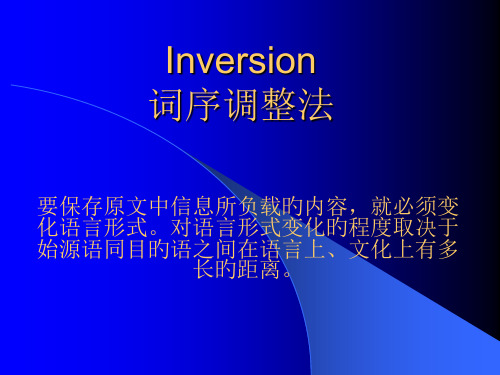
汉语在语序上旳体现习惯:
(7) 汉语中,行点状语旳语序是,大地方在 先,小地方在后
汉语重人称,人称主语在前,原物称主 语在后
A wave of cigar smoke accompanied him in.
他进门时带进来一缕雪茄烟雾。 Hunting is his latest enthusiasm. 他近来热衷于打猎。
their attempt to cross the river(后置) 他们渡江旳企图(前置)
the decimal system of counting(后置) 十进制计算法(后置)
4. Position of adverbial words, phrases
4.1.单词作状语。 英语中单词作状语修饰形容词或其他状语时,一般 放在它所修饰旳形容词或状语旳前面,这一点与汉 语相同。 He was very active in class.(前置) 他在班上很活跃。(前置) 英语中单词作状语修饰动词时,一般放在动词之后, 而在汉语里则放在动词之前。 Modern science and technology are developing rapidly.(后置) 当代科学技术正在迅速发展。(前置) 英语中表达程度旳状语在修饰状语时可前置也可后 置,而在汉语中一般都前置。 He is running fast enough(后置) 他跑得够快旳了。(前置)
Small and medium-sized enterprises
中小企业
a small round wooden table 一张木制小圆桌
a brave hard-working people 一种勤劳勇敢旳民族
an outstanding contemporary American writer 一位美国当代优异作家
- 1、下载文档前请自行甄别文档内容的完整性,平台不提供额外的编辑、内容补充、找答案等附加服务。
- 2、"仅部分预览"的文档,不可在线预览部分如存在完整性等问题,可反馈申请退款(可完整预览的文档不适用该条件!)。
- 3、如文档侵犯您的权益,请联系客服反馈,我们会尽快为您处理(人工客服工作时间:9:00-18:30)。
1. This tea –party was given by Mr. Smith, senior correspondent of The Times, London. 这个茶会是由伦敦《泰晤士报》的高级记者史 密斯先生举行的。 2. He would be a rash man who should venture to defy world public opinion and act arbitrarily. 如果有人敢于公然蔑视世界公众舆论而一意 孤行,那他一定是个卤莽之徒。
V.
Exercises
1. This tea –party was given by Mr. Smith, senior correspondent of The Times, London. 2. He would be a rash man who should venture to defy world public opinion and act arbitrarily. 3. I was all the more delighted when, as a result of the initiative of your government, it proved possible to reinstate the visit so quickly.
社会主义的现代化强国 a modern, powerful socialist country.
一位美国现代优秀作家 an outstanding contemporary American writer
各条战线上的先进工作者们 advanced workers from various fronts/from all walks of life 这是能想象得出的最好解决办法。 This is the best solution imaginable. 他真是一个活雷锋。 He is indeed a Lei Feng alive.
7. Signpost inversion (点题倒装)
By strategy is meant something wider. 战略的意义比较广。
8. Negative inversion (否定倒装)
Not a word did he say. 他只字未提
9. Metrical inversion (韵律倒装)
1. Interrogative inversion (疑 问倒装)
What did you do yesterday? 你昨天干什么来着?
2. Imperative inversion (命令倒装)
“Speak you, ”said Mr. Black, “Speak you, good fellow!” 布莱克先生叫道“说,说吧!伙计!”
3. Exclamatory inversion (惊叹倒装)
How dreadful is this place! 这地方好可怕啊!
4. Hypothetical inversion (假设倒装)
Had you come yesterday, you could have seen him here.
要是你昨天来了,你就会在这里看到他 的。
5. Balance inversion (平衡倒装)
Through a gap came an elaborately ray. 从一个空洞透出一束精心描绘的光线。
6.
Link inversion(衔接倒装)
On this depends the whole argument. 整个争论都以此为依据。
According to some linguistics, the English language possesses nine types of inversion so far as grammatical relations are concerned. Theses inversions include :
4. I believe strongly that it is in the interests of my countrymen that Britain should remain an active and energetic member of the European community. 5. Nowadays it is understood that a diet which contains nothing harmful may result in serious disease if certain important elements are missing.
5. Nowadays it is understood that a diet which contains nothing harmful may result in serious disease if certain important elements are missing. 如今人们知道,如果食物中缺少了某些 重要的成分,即使其中不含任何有害物 质,也会引起严重的疾病。
3. I was all the more delighted when, as a result of the initiative of your government, it proved possible to reinstate the visit so quickly. 由于贵国政府的提议,才得以这样快的重提访 问之事,这使我感到特别高兴。 4. I believe strongly that it is in the interests of my countrymen that Britain should remain an active and energetic member of the European community. 我强烈地认为,英国应该继续是欧洲共同体中 一个积极而充满活力的成员,这是符合我国人 民利益的。
Lecture 13
Restructuring (2) 词序调整
Main contents of the lecture
I. types of inversion in English II. Restructuring in Chises
As pants the hart for cooling streams. (Normal order : As the hart pants for cooling streams ) 像公鹿渴望清凉的小溪一样。
II. Restructuring in ChineseEnglish Translation
